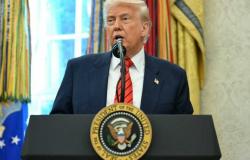Like many other species of large felines, leopards are seriously threatened by marketing.
Living or dead, they are the subject of a trade to meet the growing demand for exotic pets, or so that their bones, their skulls and their skins are used in traditional medicine, luxury products or trophies.
On the occasion of International Leopard Day, on May 3, the world Animal Protection Organization FOUR PAWS highlights the exploitation of leopards as part of the global trade in large felines.
“It is tragic to see how these majestic creatures have become simple goods“Said Vanessa Amoroso, head of wild animals.
Leopards are killed to replace the tigers.
With the growing international demand for tigers, other species of large felines such as leopards are increasingly targeted by poachers and wild animals, according to Four Paws.
Declared to purpose as coming from “tigers”, bones, teeth and other parts of the body are marketed on the Asian markets to become traditional drugs, luxury accessories, trophies and many other things.
Despite the pressure exerted on their wild populations and the strictest protection provided for by the Convention on International Trade in Wild Wildlife and Flora, threatened with extinction (CITES), around 12,000 leopards and their parties were marketed between 2020 and 2023 worldwide, according to the CITES database.
“The Leopards of Africa, the Middle East and Asia have lost almost 75 % of their natural habitats due to the destruction of habitat and poaching“Explains the NGO.
“While the populations of large wild felines are on the verge of extinction, others are raised in dubious reproduction centers for the sole purpose of being marketed worldwide, alive or in pieces.”
South Africa is a major player in the global trade in the big cats
Despite international surveillance, South Africa continues to play a key role in supplying and eating the global demand for large felines and their bodies.
-It does so by allowing the intensive farming industry in captivity to thrive in the context of its ineffective legislation, declares Four Paws.
Thecampaign group “Break the Vicious Cycle “(break the vicious circle) Documents the preponderant role of South Africa in commercial exploitation and the trade in species of large felines.
“The protection of large felines is not uniform in the world and varies from country to country. It even varies according to the species of large felines“, Ajouute Vanessa Amoroso.
“Traffickers and merchants of wild species are aware of this and are always looking for easy solutions to earn money. If it is too complicated to get a tiger, they will quickly turn to more accessible and less protected substitutes “.
“Four Paws urges governments from around the world to align with international standards for the protection of wild animals, such as CITES, in order to put an end to the unscrupulous traffic and exploitation of wild species for lucrative purposes”, specifies the NGO Four Paws.
A sanctuary for threatened leopards
Four Paws also militates for the protection of large felines on his site LIONSROCK Big Cat Sanctuary in South Africa.
It was created almost twenty years ago, in 2006, to give a second chance to the great traumatized and saved felines of exploitation, by providing them with care adapted to their species.
Two of its first inhabitants were the leopards Mike and Tulani. After being saved in 2006, they today form a “couple senior” in Lionsrock.
Tulani was born on a South African Safari farm in 2002, before being bought by its former owner to be kept as a pet. Mike was a wild leopard who was captured and kept in private captivity.
Although leopards love loneliness, Tulani and Mike quickly found comfort in the company’s company. Almost twenty years have passed, but the two leopards have always seen enjoying the African sun.








